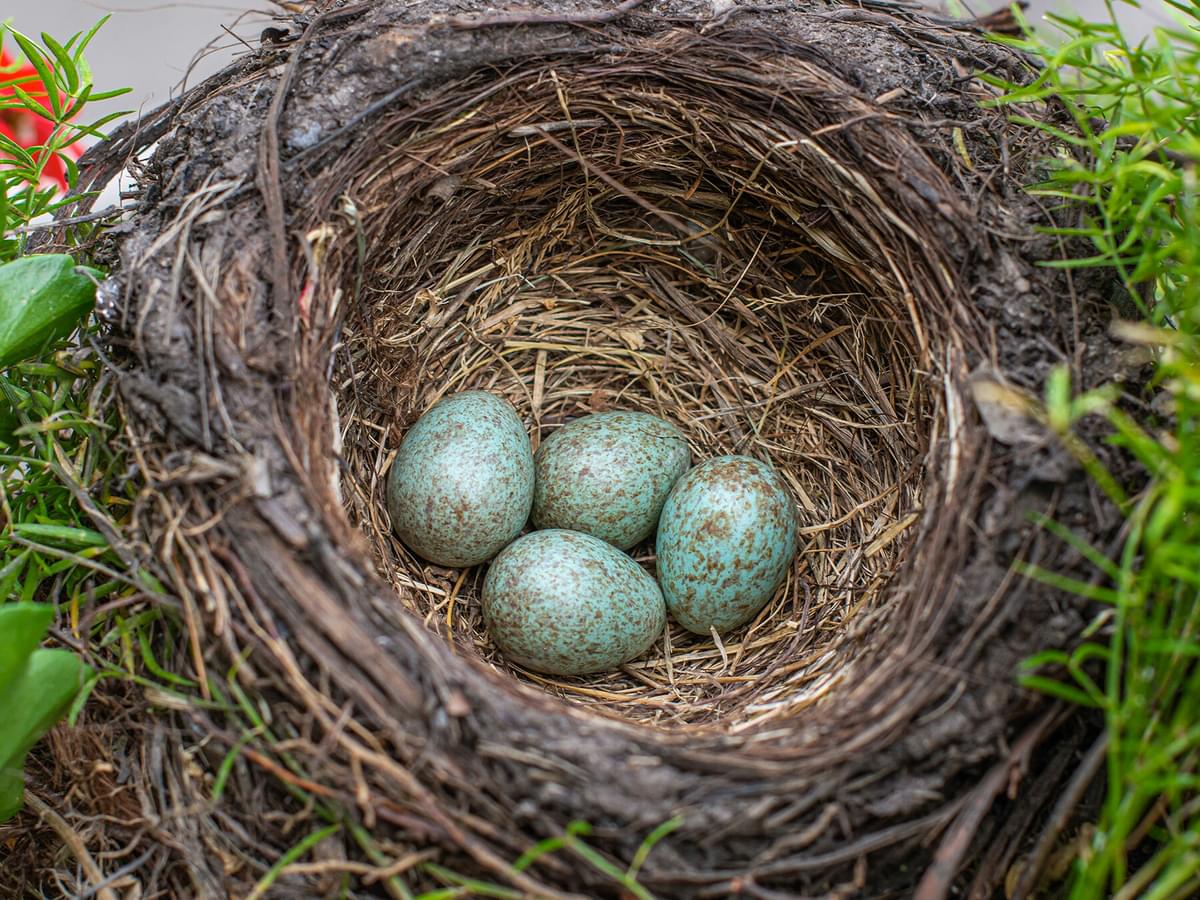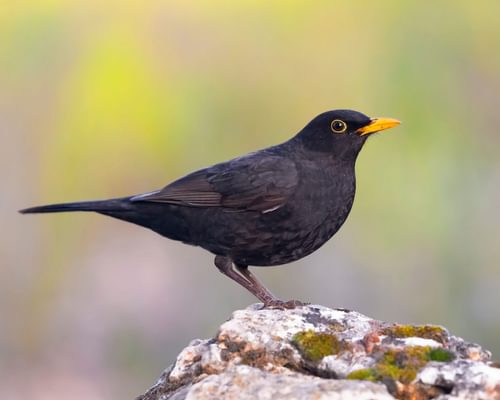The term ‘blackbird’ has become a general term for many predominantly black thrush-like birds. However, when we talk about blackbirds, the bird that springs to mind is likely the Common blackbird, a species of true thrush from the Turdidae family. There are many similar looking blackbirds in the Icteridae family, including the common North American Red-winged blackbird, but they’re barely related to their European counterparts!
Blackbirds are a common garden bird throughout much of the world, but what about baby blackbirds? This is a guide to baby blackbirds. Of course, there will be plenty of pictures of baby blackbirds along the way!
What does a baby blackbird look like?
At birth
Baby blackbirds are born altricial and naked with spare tufts of downy feathers. The birds are blind and tiny, measuring just a few centimetres long. They’re capable of squirming but can’t shuffle around the nest for a couple of days at least. Baby blackbirds have gaping yellow mouths, which they present to their parents to feed.

Recently hatched blackbird chick in the nest

Three young blackbird chicks
Growth and development
Baby blackbirds grow exceptionally quickly, obtaining around 50 to 60% of their adult body weight in the first ten days. Fluffy, downy feathers begin to grow after a couple of days, giving a 7-day-old nestling blackbird a somewhat round or rotund appearance.
After 12 to 14 days, the chicks are ready to fledge, but they can feasibly survive outside of the nest after just nine days. Blackbirds remain juveniles for some eight months and will usually breed in the forthcoming breeding season.

A recently fledged blackbird chick
How big are baby blackbirds?
Baby blackbirds are tiny, measuring just a few centimetres long, and they weigh just 2 to 4 grams.
Like most songbirds, baby blackbirds are born altricial, meaning they’re totally blind and are largely undeveloped. Hatchling birds require constant attention and can barely thermoregulate for 2 to 3 days. But, of course, young blackbirds grow extremely quickly, and by the time it comes to fledge, baby blackbirds obtain some 50 to 60% of their adult body weight.

Hungry blackbird chicks in the nest
How much do baby blackbirds weigh?
Baby blackbirds weigh around 2.75 to 3.25g at birth, which is less than a 5p piece.
At birth, nestlings weigh less than 5% of their adult weight, which is around 100g. Baby blackbirds grow rapidly, and reach approximately 3/4 of their adult weight before fledging.
What do juvenile blackbirds look like?
Juvenile blackbirds are a medium-light, speckled brown with a reddish tinge to their breast and undersides. They’re easy to confuse with many other juvenile songbird juveniles.
Moreover, both the male and female look similar for the first eight months or so, until the males moult their juvenile brown plumage and replace it with black plumage. Female adult blackbirds can be hard to tell apart from juveniles as they share similar red-brown plumage.
Juvenile blackbirds are rounder and puffier than adults. Their downy feathers are gradually replaced over the course of 6 to 10 months.

Juvenile Blackbird
What is a baby blackbird called?
There’s no specific name for a baby blackbird. Like most baby birds, baby blackbirds are generally referred to simply as chicks.
Like with other birds, there are also different names for different stages of the young blackbird’s development. Immediately after hatching, a baby blackbird is called a hatchling.
While baby blackbirds remain in the nest, they’re called nestlings. Once they leave the nest, they’re called fledglings. Finally, baby blackbirds become juveniles and then adult birds.
What do baby blackbirds eat?
Baby blackbirds eat what foods their parents bring them, which are almost exclusively soft invertebrates, insects and arthropods. While blackbirds are omnivores, young birds are unable to digest most seeds and berries until they fledge. Insects provide the high-fat, high-energy diet the young birds need to grow.
Parents feed the young a variety of worms, beetles, grasshoppers, flies and spiders, which are sometimes partially regurgitated and inserted into the chicks’ gaping mouths. The parents feed the chicks multiple times an hour for most of the day.

Female Blackbird feeding chicks a worm in the nest
Do both parents feed baby blackbirds?
Both the male and female blackbirds feed the young birds. In some situations, the female will feed more, and in others, the male will take over most of the feeding duties. This seems to vary from region to region and nest to nest.
Once the chicks fledge, the male will continue to feed them for another two to three weeks or so if possible, while the female prepares for the next brood. Blackbird pair bonds are strong and often last for life.
How do blackbirds feed their chicks?
Adult blackbirds feed their chicks by dropping whole foods into the youngs’ gaping mouths.
Arthropods and invertebrates make up most of the chick’s diet for the first week or so at least. The parents may partially regurgitate some foods into the chicks’ mouths.
Soft insects and invertebrates like worms are essential in the breeding season - these easily digestible foods are full of nutritious fat and energy.

Male Blackbird looking after the chicks
What do blackbird eggs look like?
Blackbird eggs are pale-green or blue, with large brown-to-red speckles which cover most of the surface. They measure approximately 29 x 22mm.

Blackbird eggs in the nest
How long do blackbird eggs take to hatch?
Blackbird eggs are incubated for roughly 13 to 14 days on average, though longer incubations of 19 days have been observed in colder regions.
In the UK, the average incubation time is 13 to 14 days. It’s a similar story for most North American blackbirds - the average incubation time for Red-wing blackbirds is also around 13 days. The female usually incubates the eggs as the male guards the nest, but male incubation is occasionally observed too.
How many babies does a blackbird have?
A blackbird’s average clutch of eggs numbers 3 to 5 eggs, with higher numbers being laid in woodland habitats by older individuals.
Blackbird clutches wouldn’t be large enough to keep their population stable if they raised just one brood per year, hence why female blackbirds usually lay at least two clutches of eggs a year, if not three or even four!
Blackbirds live short lives, and they’ve learned to breed and nest quickly to keep their populations high. Over 50% of nests fail in some regions, so blackbirds must try, try again if they don’t first succeed!

A fledgling common blackbird calling to be fed
When do blackbirds lay eggs?
In the UK, blackbirds lay eggs in the traditional spring breeding season, which runs from March until July.
Depending on the weather, most blackbirds will wait until April to lay their first clutch. Subsequent clutches are laid through May, June and July. Rarely, blackbirds may lay a late clutch in August.
In North America, the breeding season is pretty much the same as it is in the UK. Blackbirds in Canada and the northernmost US states typically wait until late April or May, whereas those distributed further south often breed earlier.

Eurasian Blackbird feeding a recently fledged chick a strawberry
How long do baby blackbirds stay with their parents?
Baby blackbirds leave the nest to fledge after around 12 to 14 days, but may leave sooner, after just nine days. This is only likely if the nest is disturbed.
After fledging, the young birds usually shuffle their way to a nearby branch or bush, where they’ll remain for another week or so until they can fly confidently. Parental feeding can continue for as long as three weeks in some situations. During this time, the young blackbirds are often seen chasing after their parents and begging for food.
What to do if you find a baby blackbird?
If you find a baby blackbird hopping around on the ground, the best thing to do is to try and leave it. It's parents will be near by keeping a close eye on it, and will be providing food and care. Try and keep pets away until safe for the young chick, and avoid disturbing it.
The only time to intervene, would be if there was an immediate sign of danger to the life of the fledgling. For example, if it was on a busy road or trapped somewhere, then you could calmly approach it, and put it in a safe place, such as a nearby bush.
Intervening with young bird and taking them out the wild can reduce the chances long term survival slightly, as young birds learn important skills at this early stage of development.
If the baby bird looks ill or shows any signs of injury, then contact your local wildlife organisation, or the RSPCA.
Alternatively intervening may be required if the baby blackbird looks to be abandoned or orphaned, but as previously mentioned, although you may not be able to see the parents all the time, they are usually watching nearby.

